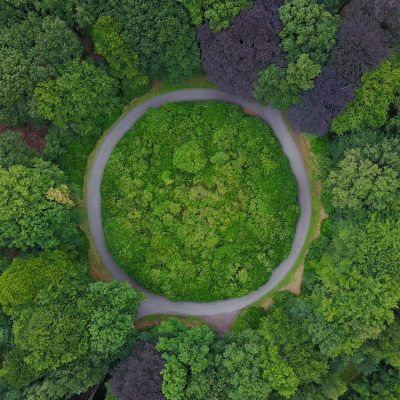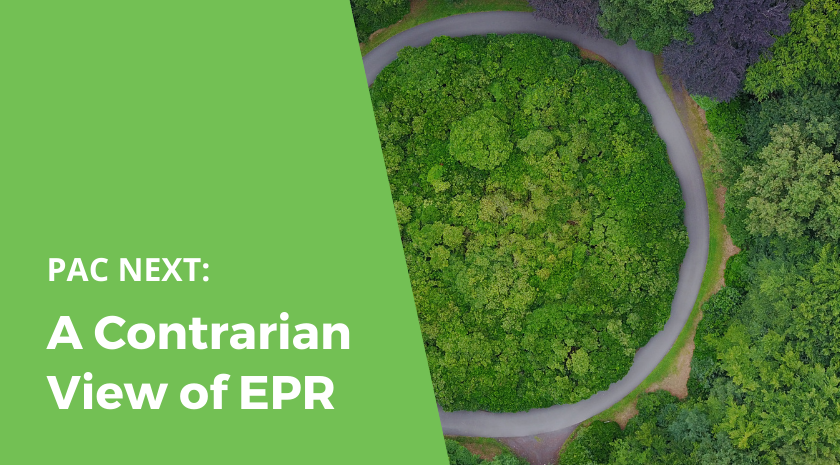From the Desk of Dan Lantz, PAC NEXT Canada Director
I have been sincerely privileged to be part of the PAC NEXT team since the program’s inception in 2011.
PAC is the only organization I work with that has representation from across the entire supply chain. It’s rewarding work because members are excited about the opportunity to work together to implement the PAC NEXT vision of “A world without packaging waste”. I’m happy sharing my technical expertise in end-of-life management and packaging design, particularly around plastics, to the organization and its members.

Today, I offer a contrarian view of EPR being the cornerstone of sustainability — not because I like to rock the boat (stop laughing everyone), but rather because I did an extensive study and found little linking EPR to program performance and packaging design (send me a note if you want more information)! EPR programs are not the primary drivers of packaging change.
Other initiatives show more promise in promoting packaging design changes. Global Plastics Pacts, such as the Canada Plastics Pact (CPP), launched Jan 2021, and the USPP, launched Aug 2020, are part of a broader global network led by the Ellen MacArthur Foundation are better policy instruments which will lead to packaging change. Both the CPP and the USPP are establishing roadmaps for Pact signatories to work toward four 2025 targets related to: recycled content; design for reuse, recycling, and composting; actual recycling and composting rate improvements; and problematic and perceived unnecessary materials. PAC is an Implementation Partner of the CPP.
Beyond the Plastics Pacts, consumer goods manufacturing companies are voluntarily setting environmental goals for packaging reusability, recyclability or compostability and the incorporation of recycled content. Further, the Consumer Goods Forum’s international packaging design initiative, the Golden Design Rules, now implemented, where I was an subject matter expert member in their development, will further advance packaging design changes. The Plastics Pacts, CPG company packaging goals, and initiatives such as the Golden Design Rules have all been implemented outside of EPR programs and will do much more to effect packaging design changes than will any EPR program on its own. This does not mean EPR should not be investigated. EPR is good for creating harmonized recycling programs across larger geographic areas, providing the opportunity for improved economies of scale, thereby promoting investment in better, more efficient recycling equipment. In other words, all initiatives need to be implemented if true change and improvement in packaging design and post-use management is to occur.
PAC is front and centre on the Canada Plastics Pact, acting as a member of the Advisory Council and directly providing subject matter expertise to the organization. Further, PAC continues to evolve its Packaging Innovation Pathway PIP360 tool, which measures a package’s circularity, considering the packaging composition, reduction, reuse, composting and recycling rates. PIP360 version 1 is currently in the marketplace, where we have secured 13 early adopters. Listening to our PAC members and PIP360 tool users, we are already working on version 2.0, with added features including more packaging material types, ensuring certification for fibre material, and compostability, and incorporating packaging intensity. Recognizing EPR is part of the Canadian landscape and should not be discounted, the new version will be able to calculate the average EPR fee for Canada for a given package. The tool, with its ability to accurately track the recycling rate for all packaging, along with the recycled content of the package, with separate reports for plastics, will be well positioned to act as the data gathering and measurement tool for the CPP. Contact Andrew Macdonald awmacdonald55@gmail.com if you would like a demo of the PIP360 model.
While these various initiatives have considerable potential to improve packaging design and post-use management, we will never reach a world without packaging waste unless we — the public — actively engage in available programs. The recycling facilities of today can effectively capture and recycle 95% or more of all materials. In other words, for every 100 tonnes of recyclable material collected for recycling, 95 tonnes (or more) go to end markets. To increase recycling rates, an ongoing culture change is required where consumers make conscious decisions on packaging choices, and ensure all used packaging is recycled properly (simply set out to be collected by the recycling program) and not wasted to landfill. As we always highlight in our PAC Circularity course, sustainability is not only environmental, but also inherently social and economic. Initiatives to eliminate waste need to reduce negative environmental impacts, in ways that also incorporate social and economic considerations.
Emerging EPR programs, Plastics Pacts and packaging design initiatives — combined with increased public awareness, participation and access — together have the potential to achieve a more circular world without packaging waste.



